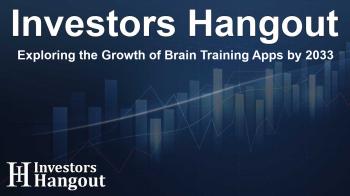Exploring the Growth of Brain Training Apps by 2033

Exploring the Growth of Brain Training Apps by 2033
Austin — The Brain Training Apps Market is on an impressive trajectory, with its size valued at USD 9.76 billion and anticipated to skyrocket to USD 39.37 billion by 2033, reflecting a remarkable CAGR of 19.07% from 2026 to 2033. This growth can be attributed to a surge in awareness regarding cognitive health and mental well-being.
Market Landscape and Driving Forces
As the dialogue around mental wellness intensifies, individuals across various demographics are increasingly turning to brain training applications. These digital platforms are designed to assist users in enhancing their cognitive skills through tailored exercises that address issues like memory loss, attention deficits, and cognitive decline due to aging. The current market climate reflects a holistic approach to health, integrating cognitive training with overall wellness.
Key Players in the Industry
Several prominent players have established a strong foothold in the Brain Training Apps sector, propelling innovation and competition. Companies such as Lumosity, CogniFit, Elevate, and BrainHQ are at the forefront, each offering unique features to engage users. As this industry evolves, new entrants target niche segments to capture the interest of consumers eager for specialized training solutions.
Segmentation Insights
Delving deeper into the market, certain segments are driving specific trends:
By Type
Memory training is currently the leading segment, with a share of 40.50%. This can be traced to widespread adoption among children, adults, and the elderly, all seeking to boost memory retention. Cognitive training, however, is quickly gaining momentum, projected to be the fastest-growing segment due to increased awareness surrounding cognitive development and its benefits in improving sports performance and problem-solving skills.
By Subscription Model
The freemium model has dominated the landscape, accounting for 45.24% of the market. This strategy allows a wide user base access to basic features while encouraging upgrades to premium options. In contrast, the paid subscription sector is rapidly expanding, driven by users seeking advanced cognitive exercises and specialized training programs powered by artificial intelligence.
By Platform
In terms of platforms, iOS leads with a market share of 38.60%, particularly in North America and Europe, where demand for high-quality applications is prevalent. Conversely, Android is witnessing the most rapid growth, fueled by increased smartphone penetration in emerging markets.
By End-User
Adults currently hold the largest market share at 50.12%, reflecting heightened awareness of cognitive health. Yet, the elderly segment is expected to experience the highest growth rate, emphasizing the need for tools that help maintain mental fitness and mitigate memory loss as they age.
Regional Insights and Growth Projections
Regionally, North America is dominant, holding a 35.02% market share. This strong position is attributed to increased awareness surrounding mental wellness and preventive care. By contrast, the Asia Pacific region is emerging as the fastest-growing area, estimated to expand at a CAGR of 20.58%, fueled by enhancements in smartphone and internet accessibility.
Recent Developments and Innovations
In recent months, the landscape has witnessed significant innovations. Notable changes included the launch of a new executive function assessment tool called 'Freeze Frame' by BrainHQ, designed to assist older adults in assessing cognitive control. Additionally, NeuroTracker has introduced diverse 3D rendering options, catering to broad user preferences, thereby enriching the user experience.
Conclusion: The Future of Brain Training Applications
As we look towards the next decade, the brain training apps market paints an optimistic picture of growth, innovation, and increasing consumer interest. With a focus on cognitive enhancement, these apps promise not only to improve users’ mental faculties but also to enrich overall quality of life. Following these trends and innovations will provide valuable insights for stakeholders aiming to capitalize on this evolving market.
Frequently Asked Questions
What is the expected market size for brain training apps by 2033?
The brain training apps market is anticipated to reach USD 39.37 billion by 2033.
Which segment currently leads the brain training apps market?
Memory training is the leading segment, representing 40.50% of the market.
What trends are driving the growth of the brain training apps market?
Growth is fueled by heightened awareness of cognitive health and the rising adoption of digital solutions for mental wellness.
Are there any recent innovations in the brain training apps sector?
Yes, recent innovations include tools like 'Freeze Frame' for assessing cognitive functions and new rendering options from NeuroTracker.
Which user demographics are targeted by brain training apps?
The primary target demographics include children, adults, and the elderly, all seeking to enhance their cognitive abilities.
About The Author
Contact Thomas Cooper privately here. Or send an email with ATTN: Thomas Cooper as the subject to contact@investorshangout.com.
About Investors Hangout
Investors Hangout is a leading online stock forum for financial discussion and learning, offering a wide range of free tools and resources. It draws in traders of all levels, who exchange market knowledge, investigate trading tactics, and keep an eye on industry developments in real time. Featuring financial articles, stock message boards, quotes, charts, company profiles, and live news updates. Through cooperative learning and a wealth of informational resources, it helps users from novices creating their first portfolios to experts honing their techniques. Join Investors Hangout today: https://investorshangout.com/
The content of this article is based on factual, publicly available information and does not represent legal, financial, or investment advice. Investors Hangout does not offer financial advice, and the author is not a licensed financial advisor. Consult a qualified advisor before making any financial or investment decisions based on this article. This article should not be considered advice to purchase, sell, or hold any securities or other investments. If any of the material provided here is inaccurate, please contact us for corrections.

